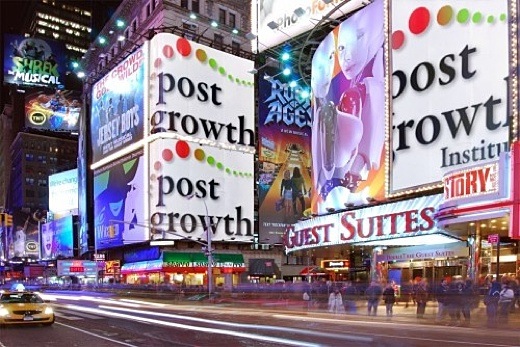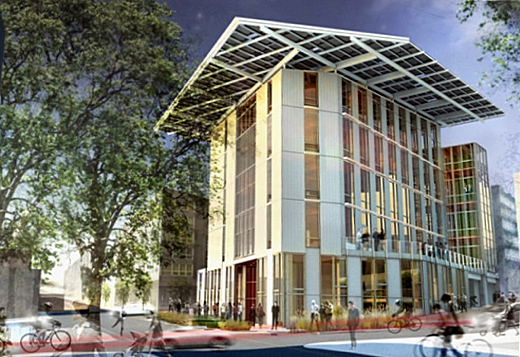By Vijay Kolinjivadi - Daniel Horen Greenford 12 January 2020 for Uneven Earth -
(http://unevenearth.org/2019/08/why-a-hipster-vegan-green-start-up-service-economy-lifestyle-cannot-be-sustainable/)

Image above: A latte bar in the area of the proposed MIL section From original article.
Dematerialized service economies, industrial veganism and hipsterized eco-aesthetics will only On the borderlands of Montreal’s well-to-do Outremont district and the ultra-hipsterized Mile End district lies an expanse of land near the Canadian-Pacific Railroad line.
This space separates these two districts from Parc-Extension (Parc-Ex for short). One of Canada’s poorest and most densely populated neighbourhoods, Parc-Ex is a port of call for many newly arrived immigrants. This is a place where affordable housing is increasingly hard to come by, and where eviction rates are on the rise.
Walking along Avenue du Parc and its adjacent streets, one begins by passing vegan chain restaurants, hip vintage clothing joints, and coffee shops jostling for space among long-time Greek and Hasidic Jewish community establishments, before eventually arriving at Parc-Ex, with its small immigrant-owned grocery stores, halal boucheries, and community centres of a very different kind of neighbourhood.
It is here, on the periphery of these stark socio-economic separations, that the University of Montréal plans to construct its science campus MIL, with an emphatic commitment to ‘sustainable development’.
Sustainability for the new MIL campus means constructing LEED certified buildings to reduce environmental impact, establishing rainwater collection infrastructure, energy-efficient lighting and heat recycling, prioritizing electric vehicles and bikes, the planting of trees—all part of broader efforts to achieve carbon neutrality.
This ethos of eco-efficiency is also shared by the new campus’ neighbours—tech firms, a Microsoft headquarters, and AI research laboratories loosely affiliated with the university. Fusing technological innovation with eco-efficiency, the MIL campus epitomizes the spirit of eco-modernism.
Underlying the emerald green image of this new campus development is the assumption that capital and economic growth will naturally follow suit.
This means ‘revitalizing’ neighbourhoods with student housing, condominiums, hip bars with micro-brews and vegan nibbles, soy and almond milk latte bars designed for socioeconomically advantaged students and professors to enjoy.
Green is gold within this logic, creating countless opportunities for advocates of Parc-Ex’s revitalization to pursue profit without the guilt.
But this modern ‘green’ vision of economic growth, hipness, and eco-conscious diets is far from regenerative. On the contrary, its success depends on creative destruction. This is what capitalism does best, and such destruction is anything but green.
In what follows, we aim to highlight the dangers of a political-economic system that continues to profit under the veil of a greener, more efficient capitalism, all while reinforcing inequality and still harming the environment.
In this way, projects like the revitalization of Parc-Ex are a continuation of Canada’s deeply colonial tradition of dispossessing First Nations of their ways of life and networks of community in favour of whatever the market dictates, however ‘green’ the market may be..
The MIL campus at Parc-Ex is just one piece of the global story behind capitalism’s ‘greening.’ To understand how they connect, we need to retrace our steps back to 1992. Against the backdrop of Soviet Union’s recent fall, the UN Earth Summit that year opened up a new global frontier for unrestrained capital.
Under the auspices of the term ‘sustainable development’ introduced at the summit, capitalism was able to tap into a panoply of ‘social’ and ‘green’ values and use them for its own ends.
In the years that followed, governments, businesses and techno-optimists teamed up with would-be environmentalists to envision a greener world that nevertheless kept efficiency at the core of its growth-oriented mandate.
Environmentalism became neutralized as a technical-managerial concern for an elite cadre of policy experts, economists, and Silicon Valley entrepreneurs, for whom new markets and techno-fixes would repeatedly affirm the exceptionalism of modern humanity.
Soon enough, environmentalism was all but depoliticized for the purposes of expanding profit under a green economy.
This depoliticization of environmentalism is what drives today’s unquestioning acceptance of the idea of dematerializing ‘green’ economic growth through more efficient lifestyles, technologies, and service-based economies.
While efficiency improvements in and of themselves are certainly to be applauded, they cannot be viewed in isolation from the economic and political structures of capital expansion from which they emerge.
For those unfamiliar with the technical details of the debate, green growth is predicated on ‘decoupling’, that is, our ability to disengage or detach economic growth from environmental impact, through things like dematerializing production or employing people in ‘cleaner’ industries (which we’ll soon explore in greater detail).
Many who have scrutinized green growth closely have concluded that the potential for decoupling by making improvements in technology—how we produce, and recycle and dispose of waste from our economy—is highly limited.
While relative improvements have been made and more are attainable still, there are hard physical limits to the extent to which our economy can be dematerialized.
Far from being the panacea that would allow unabated ‘sustainable growth’ as many green capitalists so desperately cling to, decoupling is one more siren song advanced industrial economies need to resist if they’re to avoid collapse.
Under capitalism and its relentless pursuit of growth, environmental considerations are inevitably reduced to the question of maintaining efficiency, while still expanding productive and consumptive throughput.
In turn, people concerned with minimizing their ecological footprint are led to believe that they only have one course of action: improving their own efficiency in their everyday lives by, for example, eating less meat, driving electric vehicles and biking to work.
While all these choices are constructive, focusing our efforts for systemic change through atomized personal consumption choices undermines the transition. Indeed, what green capitalism doesn’t want you to realize is that collective action is more than a collection of individualized actions.
Depoliticized environmentalism is rife in the fabulously hipsterized startup enclaves emerging in cities around the world, especially in the Global North.
Far from achieving ‘green’ efficiency, the jobs that fuel these high-tech start-ups, together with other professions of the creative class (artists, musicians, academics, graphic designers, among others), all rely on a high degree of resource demands whose impacts span the world over.
Those who argue that growth can be accompanied by a dematerializing economy typically hold the assumption that these knowledge and creative classes of the service economy have somehow lower environmental impacts than those engaged in agriculture or manufacturing (so called ‘dirty’ jobs).
But is the service economy really any cleaner and greener? The creative class and the knowledge economy are sustained by the material basis of agriculture, housing, construction, manufacturing, and other sectors.

Image above: A project sign at the site of the proposed MIL facility with the graffiti "Social Housing" spray painted over the names of the partners involved with building the MIL.
The technology that enables the knowledge economy is also far from immaterial. At the current rate of growth, internet-connected devices could consume one-fifth of global electricity demand in just 6 years from now.
While the on-site impact of an office is comparatively low to a factory or field, the cars, gadgets and food being produced in the manufacturing and agricultural sectors are mostly consumed by those employed in services.
A forthcoming study by Horen Greenford, student of Prof. Damon Matthews at Concordia University in Montreal, and colleague Tim Crownshaw at McGill, uses economic input–output modeling to reveal the impacts associated with the consumption of those employed in services.
By treating household consumption by employees as an extension of the industries that employ people, in much the same way we might analyse the environmental consequences of car production by factoring in the steel used to build them, the far-reaching impact of the service economy becomes clear.
When we observe the economy through this holistic lens, the service sector’s impact doubles in greenhouse gas emissions, triples in land use, and quadruples in water consumption, emerging as the primary driver of these three major environmental impacts.
When measured in environmental impact per unit production (impact per dollar or euro), the service sector is no ‘cleaner’ than agriculture, manufacturing, or any other sector.
Instead, all sectors approach similar levels of environmental impact per unit production when we take the household consumption of those employed in these sectors into consideration.
This isn’t to say people shouldn’t be employed in services, but that we must acknowledge the role of income and affluence as the main human driver of environmental degradation. To put it simply: Employing people means paying wages.
The higher the wages, the higher the consumption. Since people consume roughly the same per unit income, high wage jobs with low on-site impact still contribute to resource depletion and pollution just as much as those ‘dirtier’ industries. It’s just a matter of whether you see the impact or whether you distance yourself from it.
This forthcoming study hopes to dispel the illusion that there are cleaner, greener jobs found in things like high tech services. And it’s not the only one attempting to do so.
An earlier study has also shown that there is no historical evidence that service-based economies are capable of decoupling from material throughput or environmental impact.
The key takeaway here? If we continue to grow the service sector without reducing how much we collectively produce and consume, increasing the number of these high wage jobs can only lead to increased demand for material goods and services, in turn increasing their attendant environmental impacts.
Instead of decoupling, growth-oriented efficiency improvements are more likely to present us with textbook examples of the rebound effect.
First described by economist Stanley Jevons in the 19th Century, rebound effects occur when improvements in efficiency lower prices, leading to an increase in demand that outpaces these gains in efficiency.
In growth-oriented societies, the resources and energy we save through efficiency improvements are inevitably ploughed back into further growth. In other words, as airplanes, cars, and electronic devices become eco-efficient, demand for them increases, ultimately leading to greater consumption of energy and resources—a capitalist’s dream!
The more we save, the more we can re-insert into new circuits of production.
The more efficient we are, the cheaper consumption gets, and so the more we consume. The environment will always be at the losing end of this logic.
In spite of evidence that the dematerialized service economy is little more than an alluring myth, why do so many remain enthusiastic about eco-modernist visions of innovative green cities?
Well, not only do our service economies fundamentally depend on the existence of manufacturing and intensive agriculture economies, but typically those that exist on the other side of the planet.
The further away that almond milk production is from a central London coffee shop, the less guilty we feel—out of sight, out of mind. This is not only the case with the resource use of service economies, but also the waste they produce.
Exports of e-waste currently represent the fastest growing solid waste stream. As Giorgos Kallis argues: ‘Energy use in the US is not increasing, not because a peak is being reached due to technological efficiency and dematerialization, but because the US economy imports its garments from China and has its servers in Norway.’
Thus, while the service economy may appear to be materially light compared to manufacturing and agriculture, its reliance on these other sectors for its own existence (made easier to ignore by being pushed further away from where final consumption takes place) invalidates the claims that we can decouple our economy from environmental impacts via a shift to services.
We also see that any actual efficiency improvements in the service economy are quickly swallowed up by shifting costs of increasing demand to other countries where labour and resources are cheaper to exploit.
We need to get out of the habit of looking at only a small part of the whole system, often by remaining captivated by notions of national borders, for which we clearly know that neither resources, energy nor capital flows abide by.
Once again, Kallis reminds us that we should not confuse declines in environmental impact per unit of production in a growing economy with absolute and per capita resource and energy demand increases over time.
As Kris De Decker of Low-Tech Magazine informs us, global resource and energy use keeps increasing annually, growing at an average rate of 3% a year—more than double the rate of population growth.
It is therefore crucial to recognize that being so far removed from actual production and consumption patterns around the world does not exonerate our service economies, meaning that their claims to embody ‘green’ principles are only very partially accurate if at all.
Once we start paying attention to these tactics, we begin to see them in other places. Much like the dematerialized ‘green’ service economy, the purported eco-efficiency of veganism also deserves our scrutiny.
.




